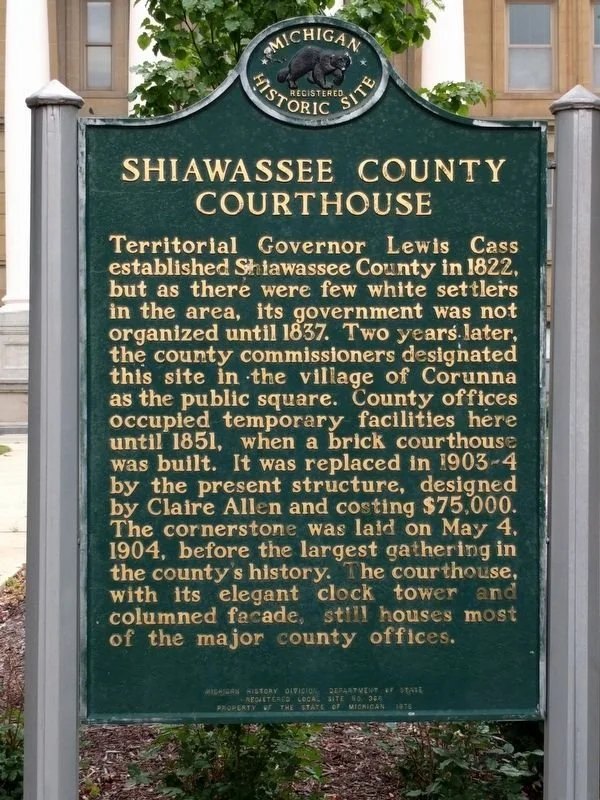Shiawassee County Courthouse
The cornerstone was laid on May 4, 1904, before the largest gathering in the county’s history. The courthouse, with its elegant clock tower and columned facade, still houses most of the major county offices.
Shaftsburg School/Woodhull Township Hall
When they were not needed at home, most children attended a one-room school about a quarter-mile west of here, just north of Beard Road. By the early 1880s, enrollment had surpassed the building’s capacity which then led to this two-room school house.
Saint Mary's Church
In 1870 Father Joseph Kraemer became pastor of a Catholic mission at Corunna that included all of Shiawassee County. In 1874 he assisted Antrim Township Irish Catholics in purchasing the Alling Schoolhouse, which he dedicated as a church.
Michigan's First Coal Mine
Alexander McArthur of Corunna discovered coal on the banks of Coal Creek in 1839. It was part of a large vein that produced coal until after World War II.
Methodist Episcopal Church
In 1837 four couples came to this area, known as Maple River, from Oakland County to claim their newly purchased acreage. They were soon followed by a dozen families. These pioneer farmers chose this vicinity because the very fertile land was well-adapted for grazing and crop production.
Maple River
In 1837 four couples came to this area, known as Maple River, from Oakland County to claim their newly purchased acreage. They were soon followed by a dozen families. These pioneer farmers chose this vicinity because the very fertile land was well-adapted for grazing and crop production.
Knaggs Bridge Area
Archaeological evidence indicates men lived in this area before the time of Christ. Chippewa Indians settled here sometime before 1790. Their village was called Kechewandaugoning, which is said to mean "Big Salt Lick."
Judd's Corner
Known more recently as Juddville, Judd’s Corners was first settled in 1853 when Connecticut native John Judd purchased four hundred acres of land encompassing this area from the Hazelton brothers, who owned much of the township.
Herman C. Frieseki/Frederick Carl Frieseke
Herman C. Frieseke built this house in 1872. The bricks used were from the tile and brick factory that he and his brother Julius had opened in 1865 beside the tracks of the Detroit, Grand Haven and Milwaukee Railroad.
First National Bank
This structure was built as a bank in 1903. The present building was designed by architect Claire Allen of Jackson and built by Burnett and Baldwin of Corunna.
First Congregational Church and Society
In 1840 thirteen people founded a Presbyterian congregation on the principles of opposition to slavery and “total abstinence from all intoxicating liquors as a beverage.” It was the first church established in Owosso.
Ellen May Tower/Spanish-American War Nurse
In 1898, Ellen May Tower, an army nurse from Byron, died of typhoid fever in a hospital tent after only ten weeks abroad. Her remains arrived in Detroit, and her funeral took place in Byron two days later. The Owosso Evening Argus hailed the event as the first military funeral in Michigan for a woman.
Durand Union Station
The Grand Trunk Railway System and the Ann Arbor Railroad built this depot in 1903, at a cost of sixty thousand dollars to serve the thousands of passengers who came to this railroad center.
Durand Railroad History/The Knights Templar Special
Durand’s first settlers began farming here in 1837. Its first railroad, the Detroit and Milwaukee, arrived in 1856, thirty-one years before the village of Durand was officially organized.
Curwood Castle
James Oliver Curwood was born in Owosso on June 12, 1878, and lived here most of his life. Writing and love of nature were his boyhood interests, and by 1908 Curwood was earning his living as a novelist. During the 1920s his books were among the most popular in North America, and many were made into movies.
Corunna Public Schools/Shiawassee Street School
The Georgian Revival-style school is trimmed in limestone. The bell in the cupola was cast in 1882 and donated by the Corunna Presbyterian Church upon the school’s completion.
Comstock Cabin
Elias Comstock was the first pioneer to erect a permanent residence in Owosso. He moved here in 1836.
Byron Cemetery
Byron Cemetery originated with the 1837 interment of Theodore H. Provost, the son of one of Byron’s founders. According to local historians, Chippewa lived on this site until it became a cemetery.
Birthplace of Thomas Edmund Dewey
Born here, above his grandfather’s general store, on March 24, 1902, Thomas Dewey is known as one of Owosso’s most famous sons. After attending the University of Michigan and Columbia University, he began a long and distinguished legal career.



















